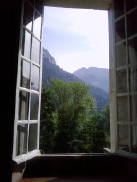I was still a graduate student when I first imagined that mathematics was actually outlining our cognitive potential (what we could see and understand). I considered writing a paper called An Asymptotic Approach to a Theory of All the Things, convinced that as the mind grew it would continue to approach the reality behind perception, but never quite get there. I never wrote the paper. But a special issue of Nature, that is a tribute to Alan Turing, brought it to mind.
It is Turing’s foresight into embodiment ideas and the way he was able to tread the shared boundaries of mathematics and biology that triggered my memory.
In one of the pieces, The incomputable reality, Barry Cooper (The School of Mathematics, University of Leeds, UK) makes the case that Turing’s work can build new bridges between mathematics and physics.
Turing was interested in the mathematics of computing and also in its embodiment – the material environment that houses it. This theme links all of his work from machines to the brain to morphogenesis. Although many mathematicians and software engineers today see it as irrelevant, embodiment is key to explaining the physical world.
Cooper likens the Universe to a turbulent stream:
A river swollen by recent rain occasionally erupts into surprising formations that we would not expect from the basic dynamics of water flow. The reason is coherence – non-local connectivity affects the water’s motion. Turbulence and other ‘emergent’ nonlinear phenomena, may not be computable with a Turing machine. Zebra stripes and tropical fish patterns, which Turing described in 1952-54 with his differential equations for morphogenesis, arise similarly.
…Modeling the evolution of the higher order effects is difficult in anything other than a broad-brush way.
Cooper argues that, like the stream, the behavior of the Universe “has many emergent levels of causality, bridged by phase transitions…We are part of an organic whole – fragmented but coherent.” He calls for a “renewed respect for embodied computing – as anticipated in Turing’s late work in the 1950’s…”
Answering the claim that Turing computation does not create anything that is not there already in the initial data, Cooper suggests
If we look at the world with new eyes, allowing computation full expression, we may come to startling conclusions.
Another piece in this special issue, Pattern formation, is from John Reinitz (University of Chicago). His piece focuses on mathematics and also references Turing’s 1952 paper.
Alan Turing’s 1952 paper on the origin of biological patterning solved an intellectual problem that had seemed so hopeless that it caused a great developmental biologist, Hans Driesch, to give up science and turn to the philosophy of vitalism.
Reinitz is speaking about the nineteenth century recognition that animal bodies develop from a pattern-less single cell, and not from a microscopic “preformed version of the adult body.” The self-organizing activity of cells could not be understood with the ideas of that century.
Before the invention of computers, applied mathematics dealt only with linear differential equations, which can amplify a pattern but not generate it.
And this is the fun part, where Turing builds some bridges – from linearity to pattern, from math to biology, from century to century. He accomplishes this by finding a way to manage diffusion (or the spontaneous intermingling of substances) before there is a way to fully represent it.
Turing’s argument involved a mathematical trick: he created a nonlinear system by turning on diffusion discontinuously in an otherwise linear system at a specific instant. Without diffusion the system is stable and homogeneous, but with diffusion, it becomes unstable and forms spatial pattern. The brilliance of the trick is that the nonlinearity is confined to a single point in time, so that at all other times, only the theory of linear equations is needed. Turing cleverly arranged to have diffusion generate pattern, rather than blur it, as it usually does.
Turing used analytic arguments of the nineteenth century to point the way towards the computational science of the twenty-first century.
This is a fine example of using what can be seen without being misled by it. Turing illuminated the path to an insight with mathematics.


Recent Comments